Architeuthid families
Richard E. Young and Michael Vecchione


This tree diagram shows the relationships between several groups of organisms.
The root of the current tree connects the organisms featured in this tree to their containing group and the rest of the Tree of Life. The basal branching point in the tree represents the ancestor of the other groups in the tree. This ancestor diversified over time into several descendent subgroups, which are represented as internal nodes and terminal taxa to the right.

You can click on the root to travel down the Tree of Life all the way to the root of all Life, and you can click on the names of descendent subgroups to travel up the Tree of Life all the way to individual species.
For more information on ToL tree formatting, please see Interpreting the Tree or Classification. To learn more about phylogenetic trees, please visit our Phylogenetic Biology pages.
close boxIntroduction
Architeuthid families consist of only two families, Architeuthidae and Neoteuthidae. Original evidence for placing these taxa together was based on morphology due mostly to the similarities of the fin attachment to the mantle, attachment of the buccal connective to arms IV and similarities of the club carpus (Roper & Young, 1972). However, recent molecular data by Lindgren (2010) and Lindgren et al., (2012) strongly support the close relationship between these two families.
Brief diagnosis:
An oegopsid with fins ...
- lacking free anterior lobes.
- attached anteriorly mostly to the muscular mantle (via fin cartilage and shell sac), not to the gladius.
Characteristics
- Fins
- Anterior fin lobes absent.
- Most of fin attaches to dorsolateral side of muscular mantle not gladius.
 Click on an image to view larger version & data in a new window
Click on an image to view larger version & data in a new window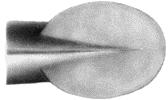
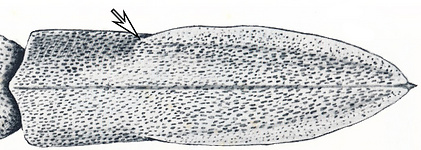
Figure. Dorsal view of the fins showing absence of free lobes and attachment to mantle muscle. Left - Architeuthis dux, 57 mm ML. Drawing from Roper and Young, 1972. Right - Neoteuthis thielei, 83 mm ML. Drawing from Young, 1972. Both features of the fin are readily seen in the A. dux drawing; in the N. thielei drawing an arrow indicates the anterior attachment point of the fin.
- Anterior fin lobes absent.
- Tentacles
- Numerous suckers present in the carpal region of the tentacle club.
 Click on an image to view larger version & data in a new window
Click on an image to view larger version & data in a new window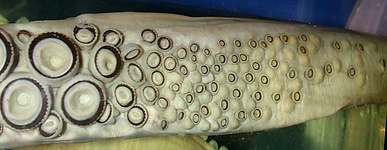
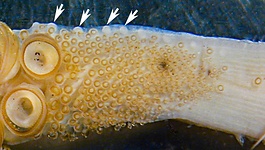
Figure. Oral view of the carpal region of the tentacular club. Left - Large Architeuthis dux. Right - Alluroteuthis antarcticus, 32 mm ML. Photographs by R. Young.
The usefullness of this character is supporting the relationship between these two families is uncertain. While the presence of numerous suckers in the carpal region is very unusual, in Architeuthis all of these suckers are paired with carpal knobs while in Alluroteuthis (and other neoteuthids) the carpal knobs (arrows) occur only along the dorsal margin of the carpal region where they are paired with distinctive carpal suckers.
- Attachment of buccal connectives
- Buccal connectives attach to the dorsal margins of arms IV.
This is an important phylogenetic character but of more general value as it is shared by the Lycoteuthidae, Enoploteuthidae, Ancistrocheiridae, Pyroteuthidae, Histioteuthidae, Psychroteuthidae, Ommastrephidae, Neoteuthidae and Bathyteuthdae.
- Buccal connectives attach to the dorsal margins of arms IV.
Discussion of Phylogenetic Relationships
On morphological grounds the relationship between the Architeuthidae and Neoteuthidae as indicated by Roper and Young (1972) is weak, however, it is stronger between these two families than either is to any other oegopsid family.
Lindgren (2010) and Lindgren et al. (2012, using molecular techniques, found also that the Architeuthidae and Neoteuthidae grouped together, with strong support. The relationship between the architeuthid families and other oegopsid families was less clear. The 2010 study found them grouping with the histioteuthid families in two of their three analyses (the other analysis was unable to determine a relationship within the Oegopsida) while the 2012 study found that they grouped most closely with the Lycoteuthidae but with weak support for the latter.
References
Lindgren, A.R. 2010.Molecular inference of phylogenetic relationships among Decapodiformes (Mollusca: Cephalopoda) with special focus on the squid Order Oegopsida. Mol. Phylogenet. Evol. 56: 77-90.
Lindgren, A. R., M. S. Pankey, F. G. Hochberg and T. H. Oakley. 2012. A multi-gene phylogeny of Cephalopoda supports convergent morphological evolution in association with multiple habitat shifts in the marine environment. BMC Evolutionary Biology 2012, 12:129-144.
Verrill, A. E. 1879. The cephalopods of the north-eastern coast of America. Part I. The gigantic squids (Architeuthis) and their allies; with observations on similar large species from foreign localities. Trans. Connecticut Acad. Sciences 5:23:177-257.
Young, R. E. 1972. The systematics and areal distribution of pelagic cephalopods from the seas off Southern California. Smithson. Contr. Zool., 97: 1-159.
Title Illustrations

| Scientific Name | Architeuthis "princeps" |
|---|---|
| Comments | Modified from Verrill, 1879. |
| Reference | Verrill, A. E. 1879. The cephalopods of the north-eastern coast of America. Part I. The gigantic squids (Architeuthis) and their allies; with observations on similar large species from foreign localities. Trans. Connecticut Acad. Sciences 5:23:177-257. |
| Scientific Name | Neoteuthis thielei |
|---|---|
| Location | Off California, USA |
| Reference | Young, R. E. 1972. The systematics and areal distribution of pelagic cephalopods from the seas off Southern California. Smithson. Contr. Zool., 97: 1-159. |
| Creator | C. McSweeny |
| View | Dorsal |
| Size | 83 mm ML |
| Collection | Santa Barbara Museum of Natural History |
| Image Use |
 This media file is licensed under the Creative Commons Attribution-NonCommercial License - Version 3.0. This media file is licensed under the Creative Commons Attribution-NonCommercial License - Version 3.0.
|
| Copyright |
©

|
About This Page

University of Hawaii, Honolulu, HI, USA

National Museum of Natural History, Washington, D. C. , USA
Page copyright © 2019 and
 Page: Tree of Life
Architeuthid families.
Authored by
Richard E. Young and Michael Vecchione.
The TEXT of this page is licensed under the
Creative Commons Attribution-NonCommercial License - Version 3.0. Note that images and other media
featured on this page are each governed by their own license, and they may or may not be available
for reuse. Click on an image or a media link to access the media data window, which provides the
relevant licensing information. For the general terms and conditions of ToL material reuse and
redistribution, please see the Tree of Life Copyright
Policies.
Page: Tree of Life
Architeuthid families.
Authored by
Richard E. Young and Michael Vecchione.
The TEXT of this page is licensed under the
Creative Commons Attribution-NonCommercial License - Version 3.0. Note that images and other media
featured on this page are each governed by their own license, and they may or may not be available
for reuse. Click on an image or a media link to access the media data window, which provides the
relevant licensing information. For the general terms and conditions of ToL material reuse and
redistribution, please see the Tree of Life Copyright
Policies.
- First online 27 February 2016
- Content changed 26 March 2019
Citing this page:
Young, Richard E. and Michael Vecchione. 2019. Architeuthid families. Version 26 March 2019 (temporary). http://tolweb.org/Architeuthid_families/149666/2019.03.26 in The Tree of Life Web Project, http://tolweb.org/




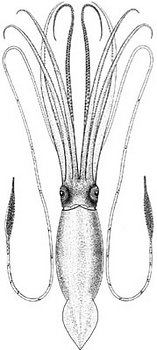




 Go to quick links
Go to quick search
Go to navigation for this section of the ToL site
Go to detailed links for the ToL site
Go to quick links
Go to quick search
Go to navigation for this section of the ToL site
Go to detailed links for the ToL site